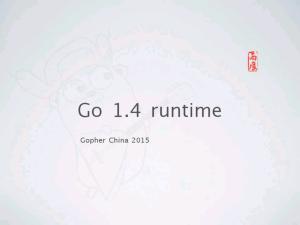- 本月热门
-
 DesignInTec:科技里的设计(当设计师参与创业) by 前田约翰
DesignInTec:科技里的设计(当设计师参与创业) by 前田约翰 -
 Go语言内存、垃圾回收、协程简介(1.4 runtime 运行环境) by 雨痕
Go语言内存、垃圾回收、协程简介(1.4 runtime 运行环境) by 雨痕 -
 AngularJS the performance parts(AngularJS性能:过去现在和未来) by toddmotto
AngularJS the performance parts(AngularJS性能:过去现在和未来) by toddmotto -
 HTTP1.1 vs HTTP2 a performance analysis(HTTP2比HTTP1性能提高66%) by mozilla
HTTP1.1 vs HTTP2 a performance analysis(HTTP2比HTTP1性能提高66%) by mozilla -
 写作即编程(Markdown标记语言简介及使用教程) by 黄增光
写作即编程(Markdown标记语言简介及使用教程) by 黄增光 -
 How To Shot Web(如何攻破网站) by Jason Haddix
How To Shot Web(如何攻破网站) by Jason Haddix -
 How to build a content and social media engine[如何构建内容和社交媒体营销引擎] by by Marcel Santilli
How to build a content and social media engine[如何构建内容和社交媒体营销引擎] by by Marcel Santilli -
 9 Thought-Provoking Quotes About Work-Life Balance(9个发人深省的关于工作生活平衡的名言) by SalesForce
9 Thought-Provoking Quotes About Work-Life Balance(9个发人深省的关于工作生活平衡的名言) by SalesForce -
 MongoDB and the Internet of Things(MongoDB和物联网) by Chris Biow
MongoDB and the Internet of Things(MongoDB和物联网) by Chris Biow -
 高性能Web应用缓存架构设计浅谈 by Robbin Fan
高性能Web应用缓存架构设计浅谈 by Robbin Fan
第1页
用RUBY解LEETCODE算 法题
RUBY CONF CHINA 2015
By @quakewang
RUBY CONF CHINA 2015
By @quakewang
第2页
LEETCODE
leetcode.com 一个在线编程网站,收集了IT公司的面试题,包括算 法,数据库和shell 算法题支持多种语言,包括C, C++, Java, Python等 2015年3月份加入了Ruby的支持
leetcode.com 一个在线编程网站,收集了IT公司的面试题,包括算 法,数据库和shell 算法题支持多种语言,包括C, C++, Java, Python等 2015年3月份加入了Ruby的支持
第3页
算法题编程界面
第4页
为什么要做算法题
面试 - 涵盖了各种经典算法题 学习 - 理解数据结构和解题思路 休闲 - 每天花5~30分钟做几道题目
面试 - 涵盖了各种经典算法题 学习 - 理解数据结构和解题思路 休闲 - 每天花5~30分钟做几道题目
第5页
为什么要用RUBY来做算法题
体验Ruby语言的生产力 学习Ruby的不常用方法 其他的语言...我不熟 :(
体验Ruby语言的生产力 学习Ruby的不常用方法 其他的语言...我不熟 :(
第6页
体验RUBY语言的生产力(I)
Permutations
Given a collection of numbers, return all possible permutations.
For example, [1,2,3] have the following permutations: [1,2,3], [1,3,2], [2,1,3], [2,3,1], [3,1,2], and [3,2,1].
// Java public List<List<Integer>> permute(int[] num) {
LinkedList<List<Integer>> res = new LinkedList<List<Integer>>(); res.add(new ArrayList<Integer>()); for (int n : num) {
int size = res.size(); for (; size > 0; size--) {
List<Integer> r = res.pollFirst(); for (int i = 0; i <= r.size(); i++) {
List<Integer> t = new ArrayList<Integer>(r); t.add(i, n); res.add(t); } } } return res;
Permutations
Given a collection of numbers, return all possible permutations.
For example, [1,2,3] have the following permutations: [1,2,3], [1,3,2], [2,1,3], [2,3,1], [3,1,2], and [3,2,1].
// Java public List<List<Integer>> permute(int[] num) {
LinkedList<List<Integer>> res = new LinkedList<List<Integer>>(); res.add(new ArrayList<Integer>()); for (int n : num) {
int size = res.size(); for (; size > 0; size--) {
List<Integer> r = res.pollFirst(); for (int i = 0; i <= r.size(); i++) {
List<Integer> t = new ArrayList<Integer>(r); t.add(i, n); res.add(t); } } } return res;
第7页
体验RUBY语言的生产力(I)
Permutations
def permute(nums) nums.permutation.to_a
end
Permutations
def permute(nums) nums.permutation.to_a
end
第8页
体验RUBY语言的生产力(II)
Length of Last Word
Given a string s consists of upper/lower-case alphabets and empty sp ace characters ' ', return the length of last word in the string.
If the last word does not exist, return 0.
Note: A word is defined as a character sequence consists of non-spac e characters only.
For example, Given s = "Hello World", return 5.
def length_of_last_word(s) words = s.split(' ') words.last ? words.last.length : 0
end
Length of Last Word
Given a string s consists of upper/lower-case alphabets and empty sp ace characters ' ', return the length of last word in the string.
If the last word does not exist, return 0.
Note: A word is defined as a character sequence consists of non-spac e characters only.
For example, Given s = "Hello World", return 5.
def length_of_last_word(s) words = s.split(' ') words.last ? words.last.length : 0
end
第9页
体验RUBY语言的生产力(III)
Add Digits
Given a non-negative integer num, repeatedly add all its digits unti l the result has only one digit.
For example:
Given num = 38, the process is like: 3 + 8 = 11, 1 + 1 = 2. Since 2 has only one digit, return it.
def add_digits(num) r = num.to_s.chars.map(&:to_i).reduce(:+) r <= 9 ? r : add_digits(r)
end
Add Digits
Given a non-negative integer num, repeatedly add all its digits unti l the result has only one digit.
For example:
Given num = 38, the process is like: 3 + 8 = 11, 1 + 1 = 2. Since 2 has only one digit, return it.
def add_digits(num) r = num.to_s.chars.map(&:to_i).reduce(:+) r <= 9 ? r : add_digits(r)
end
第10页
学习RUBY的不常用方法(I)
Add Binary
Given two binary strings, return their sum (also a binary string).
For example, a = "11" b = "1" Return "100".
# @param {String} a # @param {String} b # @return {String} def add_binary(a, b)
(a.to_i(2) + b.to_i(2)).to_s(2) end
Add Binary
Given two binary strings, return their sum (also a binary string).
For example, a = "11" b = "1" Return "100".
# @param {String} a # @param {String} b # @return {String} def add_binary(a, b)
(a.to_i(2) + b.to_i(2)).to_s(2) end
第11页
学习RUBY的不常用方法(II)
Best Time to Buy and Sell Stock II
Say you have an array for which the ith element is the price of a gi ven stock on day i.
Design an algorithm to find the maximum profit. You may complete as many transactions as you like (ie, buy one and sell one share of the
stock multiple times). However, you may not engage in multiple tran sactions at the same time (ie, you must sell the stock before you bu y again).
# @param {Integer[]} prices # @return {Integer} def max_profit(prices)
prices.each_cons(2).inject(0){|s,a| [s+a[1]-a[0], s].max} end
Best Time to Buy and Sell Stock II
Say you have an array for which the ith element is the price of a gi ven stock on day i.
Design an algorithm to find the maximum profit. You may complete as many transactions as you like (ie, buy one and sell one share of the
stock multiple times). However, you may not engage in multiple tran sactions at the same time (ie, you must sell the stock before you bu y again).
# @param {Integer[]} prices # @return {Integer} def max_profit(prices)
prices.each_cons(2).inject(0){|s,a| [s+a[1]-a[0], s].max} end
第12页
学习RUBY的不常用方法(III)
Group Anagrams
Given an array of strings, group anagrams together.
For example, given: ["eat", "tea", "tan", "ate", "nat", "bat"], Return:
[ ["ate", "eat","tea"], ["nat","tan"], ["bat"]
]
# @param {String[]} strs # @return {String[][]} def group_anagrams(strs)
strs.inject(Hash.new([])) do |h, s| h[s.chars.sort.join] += [s] h
end.map{|k, v| v.sort} end
Group Anagrams
Given an array of strings, group anagrams together.
For example, given: ["eat", "tea", "tan", "ate", "nat", "bat"], Return:
[ ["ate", "eat","tea"], ["nat","tan"], ["bat"]
]
# @param {String[]} strs # @return {String[][]} def group_anagrams(strs)
strs.inject(Hash.new([])) do |h, s| h[s.chars.sort.join] += [s] h
end.map{|k, v| v.sort} end
第13页
关于作弊(I)
Regular Expression Matching
Implement regular expression matching with support for '.' and '*'.
Regular Expression Matching
Implement regular expression matching with support for '.' and '*'.
第14页
关于作弊(I)
使用Ruby内置对象
# @param {String} s # @param {String} p # @return {Boolean} def is_match(s, p)
s =~ /^#{p}$/ ? true : false end
使用Ruby内置对象
# @param {String} s # @param {String} p # @return {Boolean} def is_match(s, p)
s =~ /^#{p}$/ ? true : false end
第15页
关于作弊(II)
Count Primes
Count the number of prime numbers less than a non-negative number.
Count Primes
Count the number of prime numbers less than a non-negative number.
第16页
关于作弊(II)
require
# @param {Integer} n # @return {Integer} require 'prime' def count_primes(n)
Prime.each(n - 1).count end
require
# @param {Integer} n # @return {Integer} require 'prime' def count_primes(n)
Prime.each(n - 1).count end
第17页
关于作弊(III)
N-Queens II
Follow up for N-Queens problem. Now, instead outputting board config urations, return the total number of distinct solutions.
N-Queens II
Follow up for N-Queens problem. Now, instead outputting board config urations, return the total number of distinct solutions.
第18页
关于作弊(III)
Test Driven Development
# @param {Integer} n # @return {Integer} def total_n_queens(n)
[0,1,0,0,2,10,4,40,92,352,724,2680,14200,73712, 365596,2279184,14772512,95815104,666090624][n] end
Test Driven Development
# @param {Integer} n # @return {Integer} def total_n_queens(n)
[0,1,0,0,2,10,4,40,92,352,724,2680,14200,73712, 365596,2279184,14772512,95815104,666090624][n] end
第19页
我的解法 V.S 别人的解法(I)
Add Digits
Given a non-negative integer num, repeatedly add all its digits unti l the result has only one digit.
For example:
Given num = 38, the process is like: 3 + 8 = 11, 1 + 1 = 2. Since 2 has only one digit, return it.
Follow up: Could you do it without any loop/recursion in O(1) runtime?
# https://en.wikipedia.org/wiki/Digital_root def add_digits(num)
1 + (num - 1) % 9 end
类似直接用算数公式证明的题目比如:Perfect Squares
Add Digits
Given a non-negative integer num, repeatedly add all its digits unti l the result has only one digit.
For example:
Given num = 38, the process is like: 3 + 8 = 11, 1 + 1 = 2. Since 2 has only one digit, return it.
Follow up: Could you do it without any loop/recursion in O(1) runtime?
# https://en.wikipedia.org/wiki/Digital_root def add_digits(num)
1 + (num - 1) % 9 end
类似直接用算数公式证明的题目比如:Perfect Squares
第20页
我的解法 V.S 别人的解法(II)
Single Number
Given an array of integers, every element appears twice except for o ne. Find that single one.
# @param {Integer[]} nums # @return {Integer} def single_number(nums)
nums.sort.each_slice(2).find{|s| s[0] != s[1]}[0] end
def single_number(nums) nums.inject(:^)
end
用XOR操作解Single Number系列的通用解法
Single Number
Given an array of integers, every element appears twice except for o ne. Find that single one.
# @param {Integer[]} nums # @return {Integer} def single_number(nums)
nums.sort.each_slice(2).find{|s| s[0] != s[1]}[0] end
def single_number(nums) nums.inject(:^)
end
用XOR操作解Single Number系列的通用解法
第21页
我的解法 V.S 别人的解法(III)
Majority Element
Given an array of size n, find the majority element. The majority el ement is the element that appears more than ⌊ n/2 ⌋ times.You may as sume that the array is non-empty and the majority element always exi st in the array.
# @param {Integer[]} nums # @return {Integer} def majority_element(nums)
nums.sort[nums.size/2] end
def majority_element(nums) nums.inject([0, 0]) {|(x, c), i| c == 0 || x == i ? [i, c+1] : [x, c-1] }[0]
end
算法出处以及单步演示
Majority Element
Given an array of size n, find the majority element. The majority el ement is the element that appears more than ⌊ n/2 ⌋ times.You may as sume that the array is non-empty and the majority element always exi st in the array.
# @param {Integer[]} nums # @return {Integer} def majority_element(nums)
nums.sort[nums.size/2] end
def majority_element(nums) nums.inject([0, 0]) {|(x, c), i| c == 0 || x == i ? [i, c+1] : [x, c-1] }[0]
end
算法出处以及单步演示
第22页
刷题能帮我应聘到好职位吗?
我也不知道呢... 不过...如果你刷了很多Leetcode,想换个工作的话... 我们正在招聘Ruby程序员,投递简历到邮箱: quake@chanyouji.com 毫无广告植入痕迹 ^_^
我也不知道呢... 不过...如果你刷了很多Leetcode,想换个工作的话... 我们正在招聘Ruby程序员,投递简历到邮箱: quake@chanyouji.com 毫无广告植入痕迹 ^_^
第23页
Q&A
